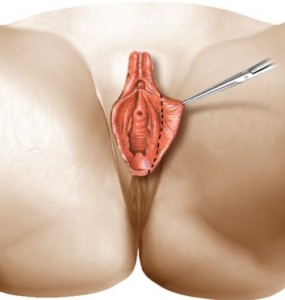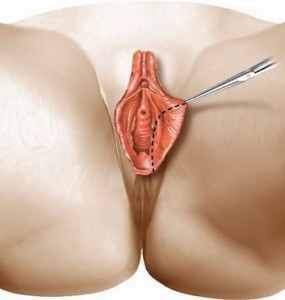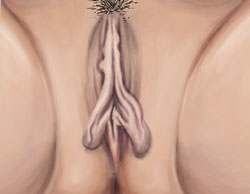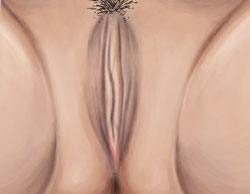What is Labioplasty?
Recently popularized by the media, labial shaping has become a commonly requested procedure. Labiaplasty or Labioplasty are synonymous terms on the web. Many women are born with larger labia that interfere with activities of daily life. Analogous to being born with massive breasts and requesting a breast reduction to improve self esteem and quality of life, women are now requesting labia reduction with shaping to improve self esteem and comfort in their lives. Large labial lips can interfere with sexual intercourse, make it difficult for sexual relationships, painful to ride horses, bikes, wear jeans, swim suits or short shorts and even difficult to exercise.
Labial reduction or Labioplasty is performed through two different methods most commonly referred to as anterior wedge resection or the trim method. This is commonly performed in the out patient setting under local anesthesia.
Labioplasty Instructions (printer-friendly)
Labioplasty Techniques
Labial reduction has been preformed for years, most commonly through a trim method. This method allows for a reduction of labial tissue through a horizontal incision that greatly reduces the discolored skin. Recently however the wedge or v – plasty anterior resection has become a popular technique for reducing the labia. The advantages of the wedge resection are that it preserves the natural shape, coloration and sensitivity through a perpendicular incision. Having two methods to choose from has allowed us to tailor the approach and in some cases improved results. The procedures popularity continues to grow as more women are electing to have the procedure at younger ages before having children and are letting others know of the benefits.
The Trim Method of Labioplasty

Labioplasty Trim Method
Most physicians offer a trim reduction of the excessive tissue. This method allows for the excess skin removal through a horizontal excision of the darkened redundant skin. In the process the extra discolored skin is removed, leaving brighter pinker skin behind. Many women like the looks of this method after healing is complete which can take up to three months. The trim method is still quite popular and can be extended to reduce the clitoral hooding as well.
The Wedge Method of Labioplasty

Labioplasty Anterior Wedge Method
The Wedge resection or v-plasty is another labioplasty procedure that allows for excessive skin reduction through a pie shaped or v excision of the redundant tissue. This procedure places the incision perpendicular to the labial edge and allows for color and neurovascular preservation. Some feel it allows for a more natural resulting lip edge shape and preserves as much of the outer lip edge and sensitivity as possible.
The wedge method requires the physician to tailor the procedure location to the individual and her concerns. This method is often combined with lateral clitoral hood unroofing as well.
Labioplasty whether done through the trim method or the wedge procedure can be combined with other enhancements such as breast augmentation, rhinoplasty or liposuction if one desires.

Before Labioplasty

After Labioplasty
Am I a candidate for labial reduction?
You may be a candidate for labial reduction if your inner labial lips hang below you outer labia majoria, you experience pain with intercourse associated with excessive pulling on the lips, difficulty with hygiene, inability to wear your clothes with confidence secondary to the labia or pain with bike or horse riding. Your plastic surgeon or other qualified physician can then evaluate your labia. It is the norm for one of the labia to be larger than the other, and asymmetries can be expected following the procedure as well. Your evaluation will proceed with a complete history and a physical examination of the area.
Options for treatment will then be discussed. For excessive labia majora, liposuction or excision of the labia majora can be offered. However, if the labia majora are too small, fat transfer may be the better treatment. Labia minor will be assessed for size and clitoral hooding as well. Often one area of the minora is excessive and a small triangle of tissue can be removed to allow for improved size as well as shape. This can often be combined with removal of excessive clitoral hooding by simply extending the incision between the majora and minora superiorly. Once the excess tissue is removed and meticulous hemostasis is achieved, shaping of the labia proceeds with customized closure. Other options include laser tightening and g-shots. However, the science and predictable of these two therapies remains to be fully elucidated and awaits further validation.
How long does it take to recover from Labioplasty?
Healing form this procedure can take up to six weeks. During this time one must keep the area clean. The sutures are absorbable and dissolve over the first 3-6 weeks. An antibiotic ointment is placed along the incision line twice a day for the first two weeks. One must maintain abstinence during the first 40 days to avoid closure dehiscence and prolonged healing. Complications are rare however suture dehiscence, hematoma, prolonged bruising, or need for additional trimming and recurrence can occur. The surgery is typically performed in an accredited facility with anesthesia to make the experience safe and comfortable. You can choose to be awake or asleep for the procedure. Most patients find that being asleep is more comfortable.
Pre and Post-Operative Instructions
How is Labioplasty performed?
At our Sacramento California practice, Dr. Perry preforms the anterior v-plasty or wedge procedure and the trim technique depending upon your individual anatomy and goals. In both methods, the targeted area of excess tissue is injected with a numbing solution following mild anesthesia, which contains epinephrine (adrenaline) and dilute local anesthetic. This fluid causes the area to go to sleep and minimizes the swelling and bruising.
Dr Charles Perry also utilizes gentle retraction and delicate handling of the tissue to better approximate the labia majoria or minora as needed. Electrocautery may also be used to decrease the post operative bruising or swelling that can sometimes be associated with labioplasty regardless of technique. Labioplasty is performed through a series of small incisions which allow the redundant unwanted skin to be removed. The nerves and lymphatics are preserved as possible to the remaining labia and the incision is closed with fine sutures that absorb once the wound has healed.
The type of anesthesia used during the procedure varies. Many patients prefer general anesthesia, though the anesthetizing fluid used makes it possible to perform the procedure while the patient is simply sedated.
Following labioplasty, you will need to wear a pad and mild compression to support the labia while swollen and apply antibiotic ointment to the lips until the incision is healed which control swelling and promote healing.
Things to Consider Before Undergoing Labioplasty
Financial responsibilities
Fees for labioplasty are not covered by health insurance and include the cost of anesthesia, lab tests, medications, cost of surgical supplies, surgery center charges, and more. If complications develop, you will incur additional charges. However, if the complication poses a health risk, your health plan will cover hospitalization, anesthesia, and/or secondary surgery.
Risks of Labioplasty
Just like any surgical procedure, labioplasty carries certain risks. While these risks are rare, those considering labioplasty should educate themselves before making their decision to undergo this procedure. Below is an introduction to labioplasty’s risks; for more information, schedule your consultation to speak with Dr. Perry about liposuction.
Bleeding and seroma (fluid accumulation)
It’s unusual, but possible, to have a bleeding episode during or after labioplasty. If significant postoperative bleeding occurs, you may require emergency treatment to drain the blood. In addition, it is possible for fluid accumulation to occur in areas around the labia. The draining of this fluid, as well as additional surgery, may be necessary.
Infection
Like Monsplasty or any other surgery we offer at our Sacramento practice, infection after labioplasty surgery is unusual. However, the rare development of an infection would require treatment using antibiotics or additional surgery.
Change in skin sensation
It’s possible to experience a temporary loss of sensation after labioplasty, but sensation will return over time. In rare cases, diminished or complete loss of sensation does not completely resolve.
Skin discoloration/swelling
Commonly, skin discoloration and swelling is experienced after labioplasty. It’s rare for swelling and discoloration to persist for a long time, and permanent skin discoloration is also unusual.
Irregular skin contour
Irregularities such as dimpling, wrinkling, and skin depressions may follow labioplasty, possibly requiring additional treatments, including surgery, to correct.
Asymmetry
Normal pre-surgery asymmetry in the body’s features is affected by skin, muscle tone, and bone prominence. Just as the body is not symmetrical before labioplasty, it will not be symmetrical afterward labioplasty and the remaining labia most likely will not be symmetric as well.
Unsatisfactory result
Despite realistic expectations about the results of labioplasty, some patients are disappointed with the outcome. In rare cases, a patient’s results are improved through additional surgery.
Surgical shock
Especially when multiple or extensive areas are treated with labioplasty, the procedure can cause severe trauma, including infections or excessive fluid loss that can cause severe illness or even death.
Long-term alterations in body contour
These can occur over time because of many circumstances unrelated to labioplasty, such as aging, pregnancy, weight loss, weight gain, or other factors.
Skin loss or chronic pain
Skin loss and chronic pain after labioplasty are extremely rare conditions, but can occur.
Pulmonary complications
In very rare cases, fat embolism syndrome — when the lungs trap fat droplets — can occur, and is sometimes deadly. This complication necessitates hospitalization and additional treatment.
Need for additional surgery
Complications from labioplasty are rare but cannot be predicted. In some cases, complications will create a need for additional surgery or other treatments. Numbness, tightness, and tissue distortion are common immediately following surgery however most resolve with time. In some cases additional tissue needs to be removed and in other cases additional tissue may need to be brought into the area. Scar revision is possible and injury to the surrounding area and structures may be required as well.



